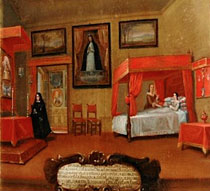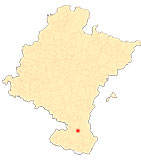Sanctuary of Nuestra Señora del Yugo
By Ricardo Fernández Gracia
Collateral altarpieces, votive offerings and ornaments
The collaterals are dedicated to San Gregorio and San Roque, both belonging to Tudela workshops of the late seventeenth century. With respect to the first one it is necessary to remember that, between the celebrations celebrated with solemnity in the sanctuary until 1863 the one of San Gregorio was included. In its attic there is a curious painting of San Gregorio Ostiense surrounded by insects and locusts.
Among the canvases, one of St. Joseph stands out, a late version of a painting with the same topic signed by Vicente Berdusán from the parish of Villafranca. Also noteworthy is another of St. Francis Xavier preaching, which follows the print by Gerard Edelinck, according to a painting by Jerónimo Sourley.
The church still conserves the jasper lavatory contracted with Juan de Estanga in 1738 and in the past it had an organ built in 1801 by the local organist Ildefonso Ulibarrena, using the pipes of the old organ and others from the parish organ that a few years earlier, between 1795 and 1797, had been rebuilt at position by the organ builder Manuel de San Juan.
Exceptionally, a couple of very interesting votive offerings have been preserved, one in relation to a hunter from 1719 and another dated 1696 that represents the interior of a Madrid house, that of the arguedano Don Esteban de Cegama, the king's accountant, whose wife was healed after invoking the Virgin of the Yoke. The canopied bed, the altar with its dais, the bedroom, the paintings of the Soledad and the landscapes, together with the royal portrait and the mirror, are an excellent example of what the interiors of the Court houses were like in the time of Charles II.
-
MUNÁRRIZ, L., El santuario del Yugo, Pamplona, Imprenta y Librería de Joaquín Lorda, 1898.
-
GARCÍA GAÍNZA, M. C. and others, Catalog Monumental de Navarra. I. Merindad de Tudela, Pamplona, Government of Navarre-Archbishopric of Pamplona-University of Navarre, 1980.
-
FERNÁNDEZ-LADREDA, C., Imaginería medieval mariana, Pamplona, Government of Navarre, 1989.
-
FERNÁNDEZ GRACIA, R., "Un aspecto de la arquitectura barroca en Navarra: los camarines", conference proceedings del I congress General de Historia de Navarra. Príncipe de Viana (1988), appendix 11, pp. 149-158.
-
ECHEVERRÍA GOÑI, P. and FERNÁNDEZ GRACIA, R., "La arquitectura religiosa de los siglos XVI al XVIII en Navarra", Ibaiak eta Haranak. Guía del Patrimonio artístico y paisajístico. Navarra, vol. VIII, San Sebastián, Etor, 1991.
-
AZANZA LÓPEZ, J. J., Arquitectura Religiosa Barroca en Navarra, Pamplona, Government of Navarre, 1996.
-
FERNÁNDEZ GRACIA, R., The Baroque altarpiece in Navarre. Pamplona, Government of Navarre, 2003.












